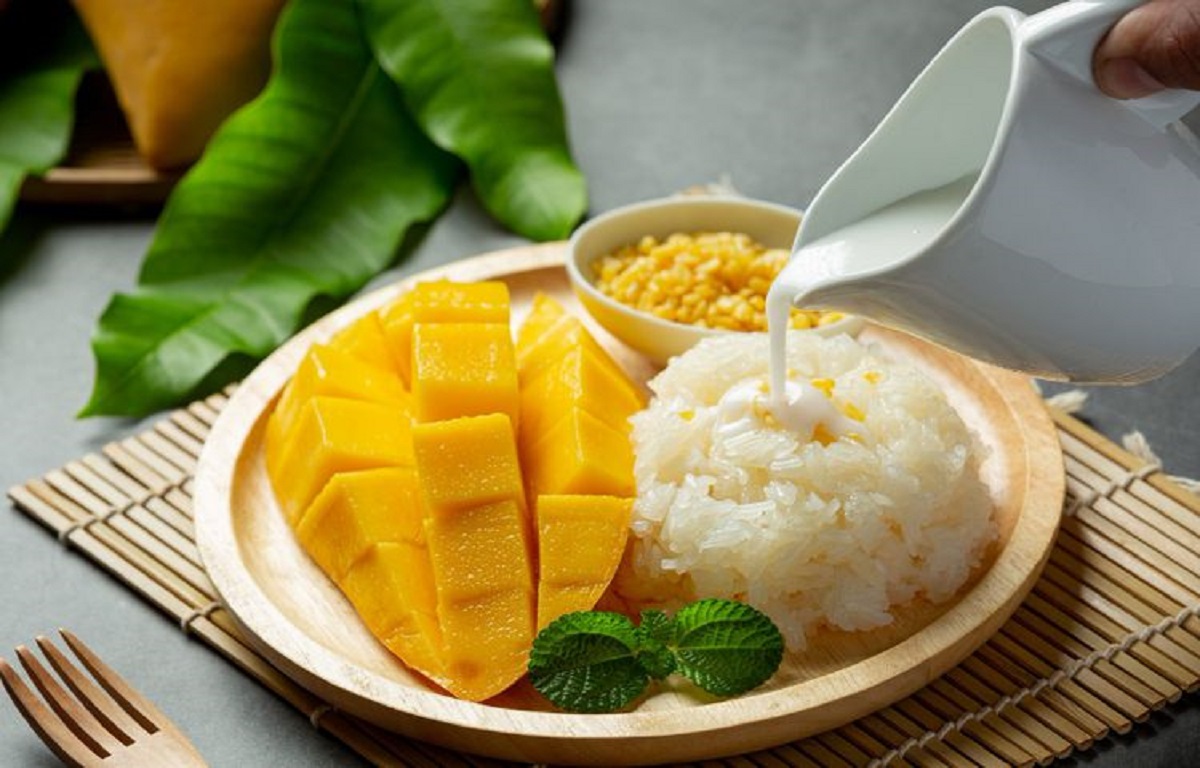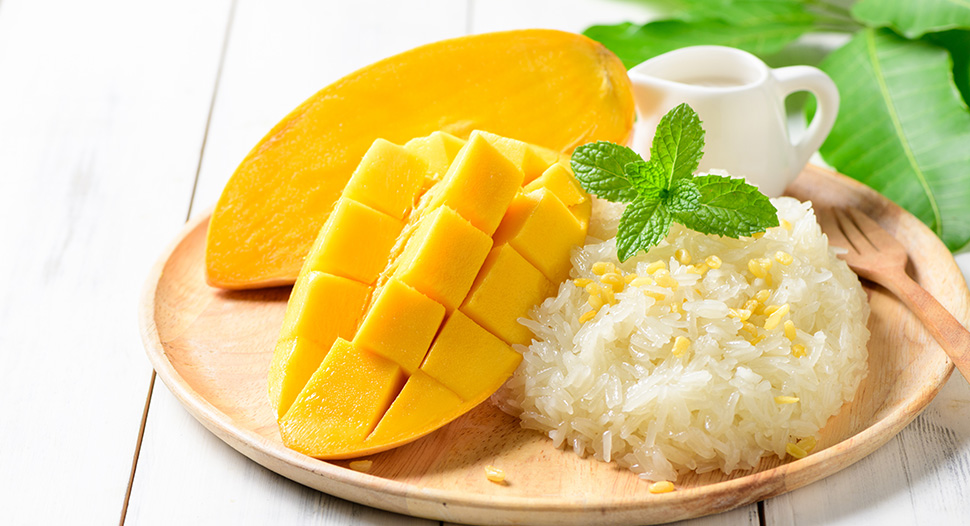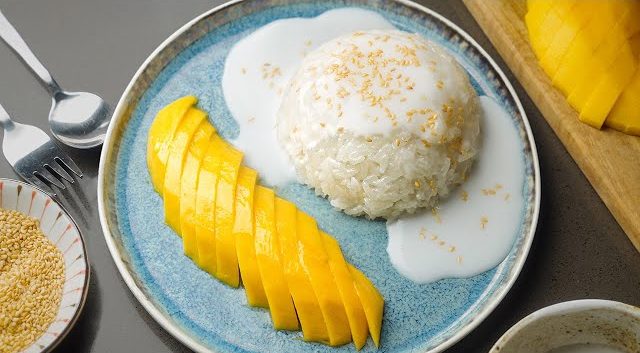Mango Sticky Rice: The Thai Way to Enjoy Fruit and Sticky Rice

Mango Sticky Rice
Mango sticky rice, known as ‘Khao Niew Ma Muang’ in Thai, is a beloved dessert in Thailand and among the most iconic dishes in Thai cuisine. This sweet dish combines the creamy, sweet flavor of ripe mangoes with the unique texture of sticky rice, all drizzled with a rich coconut sauce. In this article, we explore the origins of this dessert, how it’s made, and why it has captivated food lovers worldwide.
Origins and Cultural Significance
Mango sticky rice originates from Thailand, where mangoes are plentiful and rice is a staple. The dish is particularly popular during the mango season, which peaks from April to June. Traditionally, it is served during the hot summer months, offering a refreshing blend of sweetness and coolness. Mango sticky rice is not just a treat for the locals; it is also a symbol of hospitality and is often prepared for special occasions and festivals.
Ingredients and Varieties
The primary ingredients of mango sticky rice are simple yet distinct: glutinous rice, coconut milk, ripe mangoes, sugar, and salt. The glutinous rice, also known as sticky rice, is what gives the dessert its characteristic texture. It is soaked, steamed, and then mixed with sweetened coconut milk to create a delightful, sticky concoction. The type of mango is crucial—usually, the Nam Dok Mai variety is preferred for its sweetness and buttery flesh.
Different regions in Thailand may add twists to the traditional recipe. Some might include toasted mung beans for a crunchy texture, while others might infuse the coconut milk with pandan leaves for an aromatic flavor.
Preparation Techniques
The preparation of mango sticky rice might seem straightforward, but it requires precision and care. The rice must be soaked for several hours or overnight to achieve the right texture. It is then steamed in a bamboo steamer or a modern rice cooker. The key to perfect coconut milk sauce is the balance of sugar and salt, which enhances the rice’s flavor without overpowering the mango.
When serving, the rice is usually molded into small, compact forms, sliced mango is arranged around it, and the sweet coconut sauce is poured generously over the top. The final touch is often a sprinkle of crispy fiatogel toasted mung beans or sesame seeds.
Nutritional Profile
Mango sticky rice is not only delicious but also offers nutritional benefits. Mangoes are rich in vitamins A and C, which are crucial for immune function and skin health. The sticky rice provides carbohydrates, which are a primary energy source. Coconut milk adds a dose of healthy fats known for their heart-health benefits. However, due to its high sugar content, mango sticky rice is best enjoyed in moderation.
Global Popularity and Variations
As Thai cuisine has traveled across the globe, so has the popularity of mango sticky rice. In countries far from Thailand, adaptations have emerged, catering to local tastes and available ingredients. For instance, in some places, different varieties of mangoes or even other fruits like durian or bananas are used as substitutes.
Internationally, mango sticky rice can be found in Thai restaurants and is often featured in culinary festivals showcasing Asian cuisine. Its simplicity, exotic appeal, and delicious taste make it a favorite among people of all ages and backgrounds.
The Art of Enjoying Mango Sticky Rice
To fully appreciate mango sticky rice, one must consider the environment and setting. In Thailand, it is often enjoyed as a street food, served on colorful plates with a side of ice-cold water or Thai iced tea. The contrast of the warm, sweet rice with the cool, refreshing mango creates a delightful sensory experience.
A Timeless Thai Dessert
Mango sticky rice is more than just a dessert; it is a cultural icon that embodies the spirit of Thai cuisine—its simplicity, its flavor, and its ability to bring people together. Whether enjoyed under the shade of a tree on a hot day in Bangkok or as a sweet finale to a meal in a far-off land, mango sticky rice continues to be a testament to Thailand’s culinary prowess and its gift to the world’s gastronomic landscape.
Culinary Techniques and Tips for Perfect Mango Sticky Rice
To perfect the art of making mango sticky rice at home, attention to detail is crucial. The first step involves selecting the right kind of sticky rice. It should be labeled as ‘glutinous’ or ‘sweet’ rice, which is different from the regular white or jasmine rice commonly used in other dishes. Soaking the rice overnight helps soften it, allowing it to cook more evenly and absorb the flavors better.
When cooking the rice, consistency in steam is key. Traditional methods often employ a bamboo steamer, which allows the rice to cook gently and evenly. Modern kitchens can adapt by using a cloth-covered steamer over a pot of boiling water. The trick is to keep the rice moist and fluffy, not mushy or overly sticky.
The coconut sauce that accompanies the rice is another critical component. Using fresh coconut milk if possible can significantly enhance the flavor, although canned coconut milk can suffice when fresh is not available. The sauce should be cooked gently; boiling it might cause separation of the fats and liquids, resulting in a less appealing texture.
Serving and Presentation
The presentation of mango sticky rice can vary, but traditionally, the dish is served beautifully to entice the eater. The sticky rice is often molded into an attractive shape using a small bowl or a cup as a mold. The ripe mangoes, peeled and cut into thick slices, are arranged around the rice or sometimes artistically placed on top.
The final drizzle of coconut sauce should be done just before serving to maintain the perfect texture of the rice. Garnishes play a crucial role in adding both flavor and aesthetic appeal. Common toppings include toasted sesame seeds, which add a nutty flavor, or crispy fried mung beans for a slight crunch. These elements combine to make each bite a perfect blend of textures and flavors.
Dietary Considerations and Variations
For those with dietary restrictions, mango sticky rice offers some flexibility. Vegan versions of the dish can be made by ensuring that the sugar used in the coconut sauce is vegan-friendly and that no other animal products are used. For those looking to reduce the sugar content, natural sweeteners like agave syrup can be used as an alternative, although this might slightly alter the traditional flavor profile.
Gluten-free by nature, mango sticky rice is a great dessert option for those with gluten sensitivities. However, as with any dish prepared in various kitchens, cross-contamination can occur, so it’s always wise to ensure that all ingredients meet gluten-free standards if this is a concern.
The Role of Mango Sticky Rice in Thai Culture
In Thailand, mango sticky rice is not merely food; it is part of the cultural fabric. During the mango season, families gather to share this dessert as a means of celebrating the abundance of their local produce. It is also a popular choice during festivals and celebrations, symbolizing sweetness and prosperity.
For tourists, trying mango sticky rice is often highlighted as a must-do experience. The dish offers a taste of Thai hospitality and the richness of its agricultural bounty, all wrapped in the sweet, comforting flavors of mango and coconut.
Embracing Tradition and Innovation
Mango sticky rice is a testament to the beauty of combining simple ingredients to create a dish that transcends cultural boundaries. Whether enjoyed in its most traditional form or adapted to meet modern dietary needs and preferences, it remains a beloved symbol of Thai culinary tradition.
As mango sticky rice continues to charm food enthusiasts around the world, it serves as a reminder of the power of food to connect us to different cultures and experiences. Whether you are dining in a busy street market in Thailand or a quiet kitchen far from its shores, each bite of mango sticky rice offers a moment of sweetness and connection to a rich culinary heritage.
Mango Sticky Rice and Modern Culinary Trends
As global interest in traditional dishes increases, mango sticky rice has not only maintained its status as a cultural staple but has also adapted to fit contemporary culinary trends. In the age of social media, it has become a photogenic favorite, often featured in the feeds of food influencers and gourmet travelers. Its vibrant color contrast and appealing simplicity make it an excellent subject for food photography, further propelling its popularity worldwide.
Health Conscious Adaptations
In response to a growing demand for healthier food options, chefs and home cooks alike have begun experimenting with mango sticky rice to make it more nutritious without sacrificing its signature taste. Some adaptations include substituting traditional white sticky rice with black or purple rice, which offers higher amounts of antioxidants, fiber, and nutritional benefits. Additionally, reduced-fat coconut milk can be used to decrease the overall caloric content while still providing the creamy texture and flavor that the sauce requires.
Fusion Cuisine Innovations
The versatility of mango sticky rice makes it an excellent candidate for fusion cuisine, where it can be blended with elements of other culinary traditions to create innovative dishes. For example, some chefs have introduced mango sticky rice spring rolls, incorporating the dessert into a crispy wrapper that adds a delightful textural contrast. Others have experimented with mango sticky rice parfaits, layering the rice with mango and coconut cream in a visually appealing format that appeals to a dessert-loving audience.
Educational and Cultural Exchanges
Cooking classes focusing on Thai cuisine often highlight mango sticky rice as a key dish not only because of its popularity but also due to its cultural significance and relative ease of preparation. These classes serve as a bridge for cultural exchange, allowing people from different backgrounds to connect with Thai culture through its food. Moreover, these sessions often discuss the history of the dish and its ingredients, providing deeper insights into Thailand’s agricultural practices and seasonal rhythms.
Environmental and Economic Impacts
The popularity of mango sticky rice has also impacted local economies in Thailand. The demand for high-quality mangoes like the Nam Dok Mai variety has led to increased attention to sustainable farming practices. As more consumers become aware of the origins of the ingredients, there is a growing trend toward supporting small-scale farmers and sustainable agriculture, which helps preserve Thailand’s natural resources while boosting its economy.
Celebrating a Timeless Delicacy
Mango sticky rice exemplifies how traditional dishes can adapt and thrive in the global culinary scene. It is a celebration of Thai culture, a testament to the adaptability of classic recipes, and a beacon of the global movement towards culinary diversity and health-conscious eating. As it continues to spread across the globe, mango sticky rice not only brings a taste of Thailand to new audiences but also invites them to explore the rich tapestry of flavors, textures, and traditions that Thai cuisine has to offer.
In conclusion, mango sticky rice remains a vibrant, beloved dish that resonates with people all over the world, symbolizing not just the sweetness of Thai desserts but also the warmth and hospitality of Thai culture. As it evolves with time, it continues to enchant food lovers, inviting them to discover and appreciate the profound simplicity and profound cultural heritage it represents. Whether enjoyed in its most authentic form or through innovative adaptations, mango sticky rice will undoubtedly continue to be cherished for generations to come.
Also read this article: Acid Reflux Surgery: When Is It Necessary and What to Expect







Leave a Comment